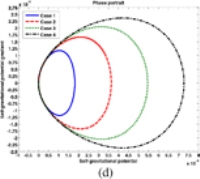The birth of stars is an event that eludes intuitive understanding. It is the collapse of dense molecular clouds under their own weight that offers the best sites of star formation. Now, Pralay Kumar Karmakar from the Department of Physics at Tezpur University, Assam province, India, and his colleague have proposed a new model for investigating molecular cloud fluctuations at sites of star formation and thus are able to study their pulsational dynamics, in a paper published in EPJ D.
 Nonlinear Pulsational Eigenmodes of a Planar Collisional Dust Molecula
Nonlinear Pulsational Eigenmodes of a Planar Collisional Dust Molecula
Dust molecular clouds are a type of astrophysical plasmas, which are composed of a primordial soup of positively and negatively charged particles. Scientists have long known that these exhibit collective pulsating or wave-like behaviour. Both experimental observations via spacecraft, satellites, and sophisticated imaging detection systems have confirmed it. What is more, many theoretical models provide a simplified description of such observations. But the complex dynamics are still not clearly understood.
In particular, the pulsating dynamics of inhomogeneous molecular clouds that periodically undergo both self-gravitational contraction due to the weight of the massive dust grains, and electrostatic expansion resulting from the interaction of dust grains of the same electric charge, are captivating scientists.
Karmakar and Bhupen Borah designed a model for investigating the cloud fluctuations with charge-varying grains, as a function of weight and charge interaction (referred to as nonlinear gravito-electrostatic coupling). The principal factors they took into account include dust-charge fluctuations, relevant convective nonlinearities and all the complex collisional processes.
They then carried out a detailed shape analysis to characterise these clouds on the astrophysical scale. This approach helps to elucidate basic features of the collapse of clouds under their own weight, the formation and evolution of stars, galactic structures and other cluster-like astrophysical objects in diverse space and plasma environments.